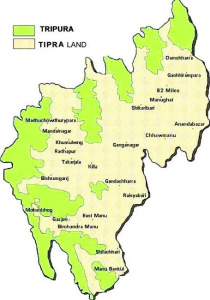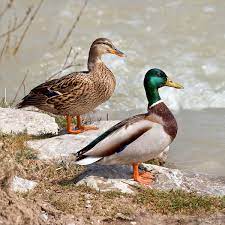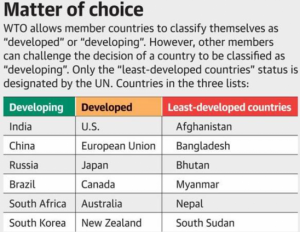Table of Contents
THE POLITY AND GOVERNANCE
1. DEMAND FOR ‘GREATER TIPRALAND’
THE CONTEXT: The demand has grown louder to carve out a separate state of ‘Greater Tipraland’ for the indigenous communities in Tripura under Article 2 and 3 of the Constitution.
THE EXPLANATION:

- Several tribal outfits in Tripura have joined hands to push their demand for a separate state for indigenous communities in the region, arguing that their “survival and existence” was at stake.
- Among the political parties that have come together for the cause are TIPRA Motha (Tipraha Indigenous Progressive Regional Alliance) and IPFT (Indigenous People’s Front of Tripura), which had so far been rivals in the electoral fray.
What is their main demand?
- The parties are demanding a separate state of ‘Greater Tipraland’ for the indigenous communities of the north-eastern state. They want the Centre to carve out the separate state under Article 2 and 3 of the Constitution.
- Among the 19 notified Scheduled Tribes in Tripura, Tripuris (aka Tipra and Tiprasas) are the largest. According to the 2011 census, there are at least 5.92 lakh Tripuris in the state, followed by Reangs (1.88 lakh) and Jamatias (83,000).
What does the Constitution say?
- Article 2 of the Constitution deals with admission or establishment of new states. “Parliament may by law admit into the Union, or establish, new States on such terms and conditions, as it thinks fit,” it states.
- Article 3 comes into play in the case of “formation of new States and alteration of areas, boundaries or names of existing States” by the Parliament.
How did the demand originate?
- Tripura was a kingdom ruled by the Manikya dynasty from the late 13th century until the signing of the Instrument of Accession with the Indian government on October 15, 1949.
- The demand mainly stems from the anxiety of the indigenous communities in connection with the change in the demographics of the state, which has reduced them to a minority. It happened due to the displacement of Bengalis from the erstwhile East Pakistan between 1947 and 1971.
- From 63.77 per cent in 1881, the population of the tribals in Tripura was down to 31.80 per cent by 2011. In the intervening decades, ethnic conflict and insurgency gripped the state, which shares a nearly 860-km long boundary with Bangladesh. The joint forum has also pointed out that the indigenous people have not only been reduced to a minority, but have also been dislodged from land reserved for them by the penultimate king of the Manikya dynasty Bir Bikram Kishore Debbarman.
THE ENVIRONMENT AND ECOLOGY
2. MALLARD SPOTTED IN HYDERABAD
THE CONTEXT: The Mallard or the wild duck with an iridescent green or blue-headed plumage was spotted in the Hyderabad.
THE EXPLANATION:

- The Himalayan Mallard belongs to the duck family and is commonly seen in the colder regions of north India but not seen in the western and southern regions of the country. While a few rare sightings have been recorded in the western belt of Maharashtra, there is no recorded sighting to date in Telangana.
- Scientifically known as Anas Platyrhynchos, and commonly called the wild duck, the Mallard belongs to the duck family but has a most distinctive feature in the iridescent green or blue-headed plumage of the male.
- The Mallard is a dabbling duck that feeds on all aquatic plants and vegetation near the surface of the water as well as insects and snails. Mallards are domesticated and are commonly-reared pets in areas where they are easily found and are reared for food.
Presence in India: Mallard is found in the north and central part of India. It can also be spotted in the Madhav National Park, Panna National Park, Nameri National Park, Bharatpur Bird Sanctuary and Hemis National Park in India.
Habitat: Mallards prefers shallow inland waterways, such as ponds, lakes, rivers, reservoirs, and marshes.
Diet: Mallard are omnivorous and feeds on seeds, plants, shoots, buds, grain, acorns, aquatic invertebrates and insects. In most parts, humans provide them abundant food throughout the year.
Protection Status:
- IUCN: LEAST CONCERN
- Wildlife Protection Act: Schedule-IV
THE ECONOMY
3. CHINA A ‘DEVELOPING’ COUNTRY TAG’ AT WTO
THE CONTEXT: China’s status as a ‘developing country’ at the World Trade Organization (WTO) has become a contentious issue with a number of countries raising concerns over the upper middle-income nation deriving benefits reserved for developing countries under WTO norms.
THE EXPLANATION:
The concerns have been raised over the ‘least developed country’ (LDC) status, with Bangladesh potentially losing this tag after surpassing India in terms of GDP per capita.
What are the benefits of ‘developing country’ tag?
- Certain WTO agreements give developing countries special rights through ‘special and differential treatment’ (S&DT) provisions, which can grant developing countries longer timeframes to implement the agreements and even commitments to raise trading opportunities for such countries.
- WTO pacts are often aimed at reduction in government support to certain industries over time and set more lenient target for developing nations and grant them more time to achieve these targets compared to developed ones.
- The classification also allows other countries to offer preferential treatment.
How is a ‘developing country’ decided and why are some against China being classified as one?
- The WTO has not defined ‘developed’ and ‘developing’ countries and therefore member countries are free to announce whether they are ‘developed’ or ‘developing’.
- However, given the rise in China’s per capita income to become an upper middle-income country according to the World Bank and the country’s alleged use of unfair trade practices such as preferential treatment for state enterprises, data restrictions and inadequate enforcement of intellectual property rights, a number of nations have called on China to either refrain from seeking benefits available to developing countries or forego its classification as a developing country altogether.
- “One way for China to show leadership would be by refraining from claiming benefits that would correspond to a developing country in ongoing negotiations”.
- The US, EU and Australia had recommended that China relinquish “its access to special and differential treatment”. China’s per capita income was $10,435 in 2020 according to the World Bank while that of India was $1,928.
What are the benefits of LDC classification?

- The WTO recognises LDCs relying on a classification by the UN based on a criteria that is reviewed every three years. LDCs are often exempted from certain provisions of WTO pacts.
- Bangladesh, currently classified as an LDC, receives zero duty, zero quota access for almost all exports to the EU. It is, however, set to graduate from the LDC status in 2026 as its per capita GDP has risen sharply surpassing that of India in FY21.
Status of India:
India has self-designated itself as a developing nation and is accordingly, classified by the World Bank as a lower-middle-income economy.
THE MISCELLANEOUS
4. UNESCO ON WORLD HINDI DAY
THE CONTEXT: UNESCO announced that on the occasion of World Hindi Day, UNESCO’s World Heritage Centre has agreed to publish Hindi descriptions of India’s UNESCO World Heritage Sites on WHC website.
THE EXPLANATION:
World Hindi Day
- It is also called Vishwa Hindi Divas. It is celebrated on January 10 to mark the first World Hindi Conference held on January 10, 1975. It was held in Nagpur. It was hosted by the then Prime Minister Indira Gandhi. Around 30 countries participated in the conference.
- The main aim of celebrating the day is to promote Hindi language all over the world. The decision of celebrating January 10 as World Hindi Day was made during a World Hindi Conference held in 2005. This was announced by the then PM Manmohan Singh. The first World Hindi Day was celebrated in 2006.
How is World Hindi Day different from National Hindi Divas?
- The National Hindi Divas is celebrated on September 14. This day is celebrated to commemorate the adoption of Hindi as the official language. This is celebrated in India. While World Hindi Day is observed by the Indian embassies located in foreign lands.
- Hindi is spoken by more than 260 million people. It is the fourth most spoken language in the world. The most widely spoken language is English. It is followed by Spanish and Mandarin.
World Heritage Sites
- These are natural or man-made areas. These sites require special protection. They have international importance. The World Heritage sites are important for humanity. They hold great cultural value.
- The sites list is maintained by the WHP. It is made of 21 member states. In order become a World Heritage Site, the place should be historically and geographically unique. The site is chosen in the interest of international community and based on national interests.
- However, the recommendations to include a site under the list are made by the member countries.
THE PRELIMS PRACTICE QUESTIONS
QUESTION OF THE DAY 12TH JANUARY 2022
Q1. Consider the following statements about Henley Passport Index:
- It ranks world’s passports according to the number of destinations their holders can access without prior visa.
- Ranking is based on data from International Air Transport Association (IATA).
- India is ranked 90 th in its 2022 index.
Which of the statements given above is/are correct?
a) 1 only
b) 1 and 2 only
c) 2 and 3 only
d) 1, 2 and 3
ANSWER FOR 11TH JANUARY 2022.
Answer: a)
Explanation:
- Statement 1 is correct: National Clean Air Program (NCAP) was launched in 2019 to reduce
levels of PM 2.5 and PM 10 in certain cities (called non-attainment cities) which fail to meet
the National Ambient Air Quality Standards (NAAQS) in five year period.
- Statement 2 is incorrect: It aims to reduce particulate matter levels in those cities by 20-30% in 2024.

